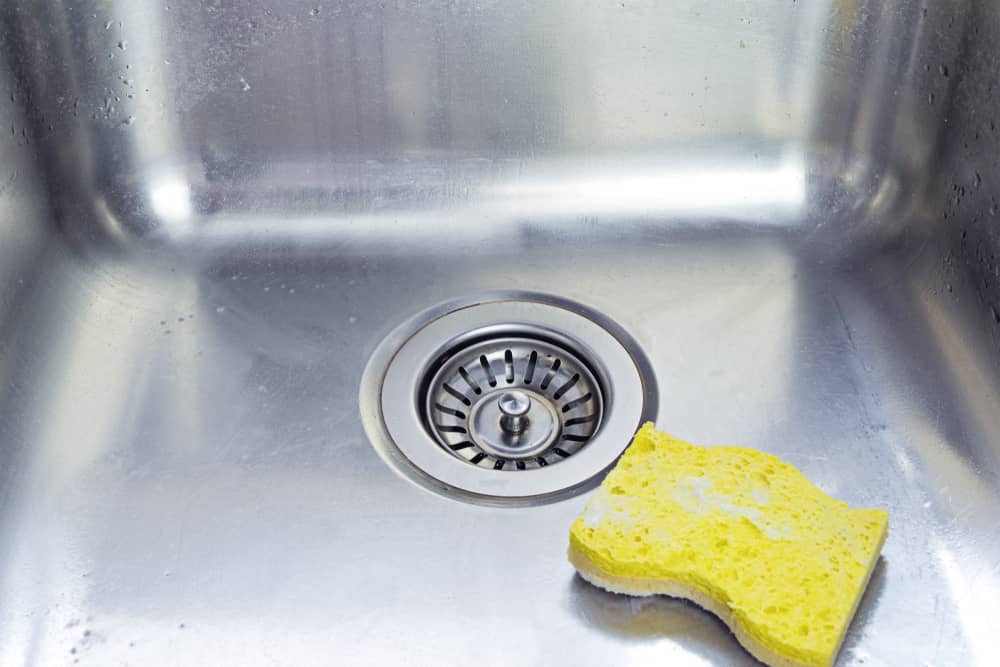We often wish that our homes would clean themselves – which, unfortunately, never happens. And while it’s essential to keep every part of our houses clean, that goes double for the kitchen!
You always want a clean place to prepare food and clean up, so that means tidying up the fridge, microwave, oven… and the kitchen sink.
No, your sink doesn’t get clean when you wash dishes.
Leftover food scraps, food particles, soap scum, and other dirt builds up on the surfaces. This means it’s imperative that you wash out the sink after the day’s load of dirty dishes.
For a stainless steel kitchen sink, you can rinse it with hot water then sprinkle bicarb soda to scrub the sink basin. If your sink is ceramic or porcelain, use a soft cloth and a 1:1 mixture of white vinegar and water. Then for aluminium sinks, regular soapy water should be fine – but you can use borax for a deeper clean.
Need to know how to clean a kitchen sink? Roll up those sleeves and get ready to get wet.
How Often to Clean the Kitchen Sink
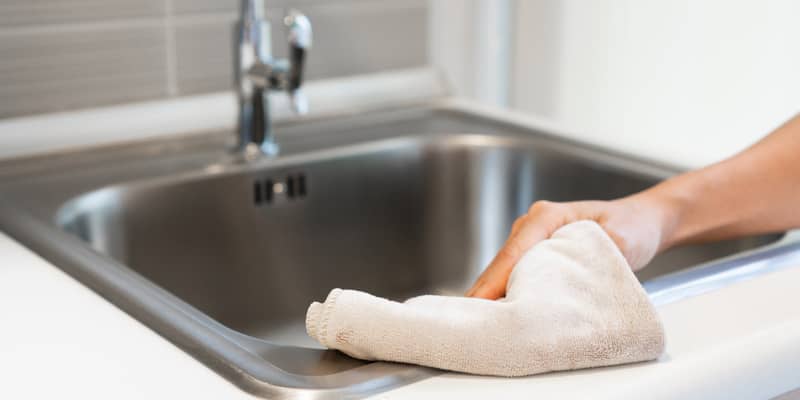
Ideally? You should clean the kitchen sink every day when you’re done with all the cooking and washing dishes.
If you handled raw meat, wash the sink with dish soap and hot water immediately.
At a minimum, wash the sink with mild dish soap and boiling water every evening. Then deep clean the kitchen sink once a week.
What to Use to Clean a Kitchen Sink
That’ll depend on what your sink is made of!
Here are the different sink materials and tips for cleaning them:
- Stainless steel sinks: Soapy water and white vinegar
- Ceramic or porcelain sinks: Vinegar
- Aluminium sinks: Soapy water or borax. Avoid bicarb soda and vinegar.
If you’re uncertain about cleaning the kitchen sink and drain, though, just leave it up to cleaning professionals.
They’ll get everything in your kitchen sparkling – and ready for your next homemade meal.
Cleaning Kitchen Sinks
To clean your kitchen sink, start by washing dishes and putting them away. Letting dishes pile up makes your sink dirtier – and poses a health hazard to you and your loved ones.
Once you’re done, rinse the entire sink with some warm water to remove crumbs and food splatters.
You can also opt to use a natural cleaner instead of dish soap, such as Koala Eco’s natural multi-purpose kitchen cleaner!
How to clean a stainless steel sink
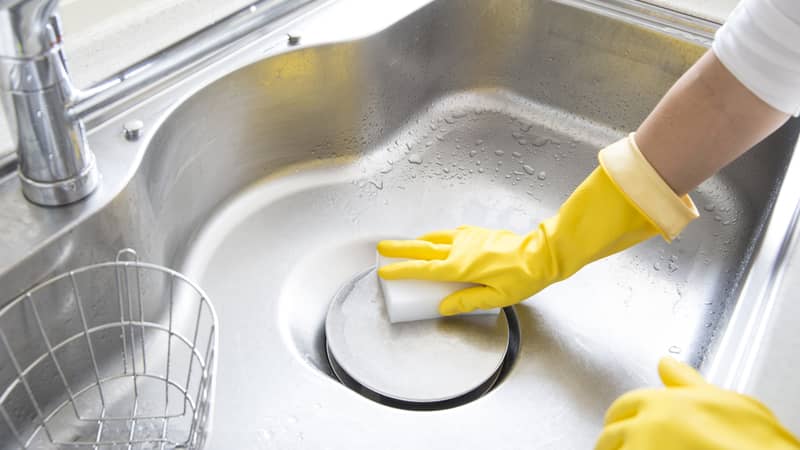
When it comes to cleaning stainless steel, it’s pretty straightforward – even for the sink!
Just fill the sink with warm water and mild dish soap. Then take a microfibre cloth and use it to scrub the surfaces.
Rinse the sink thoroughly afterwards, and wipe it dry – a wet sink may develop water spots.
If there are stubborn stains, you can dip a wet cloth in bicarb soda. This cleaning product makes for a gentle abrasive solution that’ll scrub off any stains or stuck-on food.
Alternatively, dip a sponge into some vinegar to wipe the stains away. Just make sure to rinse the sink right after!
How to clean a porcelain sink or ceramic sink
When it comes to these sink materials, they’re very easy to clean.
Mix a 1:1 solution of water and vinegar, and use it to dampen a microfibre cloth. Scrub the surface carefully and rinse thoroughly right after.
Don’t leave your cleaning solution to sit on the surface!
For tough stains, you can sprinkle some salt on half a lemon.
Use the lemon to directly scrub the surfaces, then wash with hot water and a few drops of dish soap.
Dry with a microfibre cloth.
How to clean an aluminium sink
All-natural cleaners like vinegar and lemon juice are acidic, so try to avoid using these on aluminium surfaces.
Instead, you can sprinkle some borax over the entire sink. It’ll cut through grease and remove water stains.
Take a damp cloth and wipe the borax off the aluminium.
Follow the grain of the metal and don’t use a circular motion – that could cause smudges.
Finally, rinse the sink to remove any residue, then wipe it dry.
How to Clean a Kitchen Sink Drain
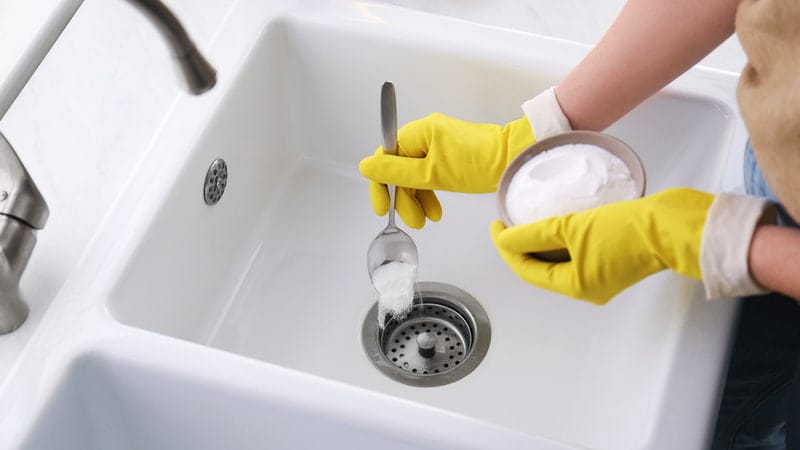
All sorts of unpleasant things accumulate in the sink drain, so it’s essential you clean it alongside the sink.
Otherwise, you’ll have a build-up of gunk that could clog the drain and cause nasty odours.
To clean the sink drain, you’ll need:
- Boiling hot water
- bicarb soda
- Optional: white vinegar
Start by boiling water, then slowly pour it down the sink drain. Try to swirl it so it flows over the entire circumference of the pipe.
Be careful, though – you don’t want to burn yourself!
Next, toss half a cup of bicarb soda down the drain. Let it sit for 5–10 minutes, then rinse and drain with hot water from your sink.
You can get rid of odours by pouring lemon juice or vinegar down the drain. Wait 30 minutes, then rinse.
Cleaning the Insinkerator
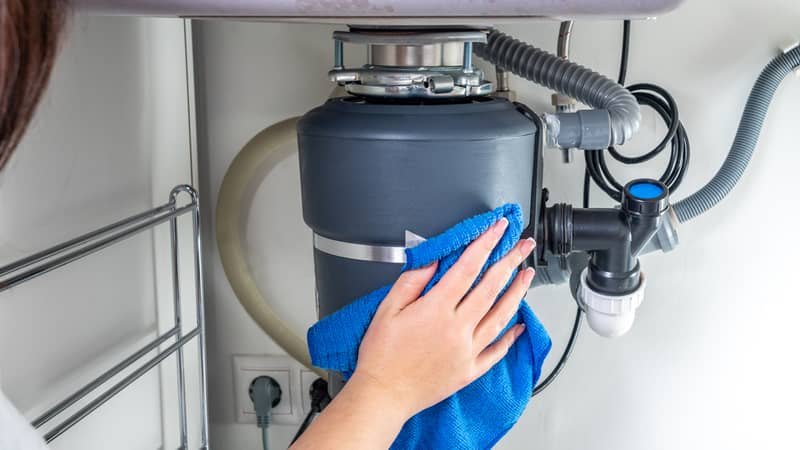
Or that thing which people across the ocean call the “garbage disposal.” Even if you regularly clean the sink and drain, you’ll still need to maintain the insinkerator. This reduces the chances of debris and odours building up.
Start by switching off and unplugging the insinkerator for safety purposes.
Scrub the baffle with abrasive scrubbers such as a sponge, and some soapy water.
Then move to the top of the grinder, rinsing frequently.
Once you’re done, sprinkle bicarb soda onto the insinkerator and let it sit for a few minutes. This will absorb any remaining odours.
Rinse and dry everything thoroughly.
How to Unblock a Kitchen Sink
Sometimes food debris and soap scum build up in the kitchen sink drain, causing a blockage.
When that happens, it’s important to know how to unclog a kitchen sink so your sink drains properly.
There are four ways to get rid of a block in your sink pipes – so choose which works best for you!
Using hot water
Sometimes, good old hot water will do the trick. Slowly pour boiling hot water down the drain, pausing in between pours to let the hot water flow down and melt any blockages.
Keep going until you can hear the water flowing smoothly.
Do not use this method if you have PVC or plastic pipes that are not rated for high temperatures.
You could cause your pipes to wrap or melt, leading to further damage.
Using a drain unclogger
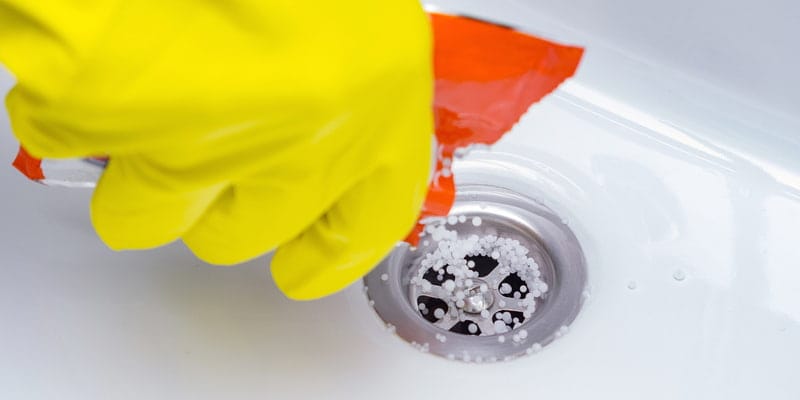
There are commercial drain uncloggers available that can help remove blockages in your drain.
Choose one that’s highly rated (and preferably, eco-friendly!). Use as directed and ensure you take all safety precautions.
If you’d prefer a more natural method, start by pouring boiling water down the drain.
Follow it with a cup of bicarb soda, then finally a cup of white vinegar.
Plug up the drain and let it sit for 10 minutes.
Pour more boiling water down the drain to clear any residue. You may repeat as necessary.
Using a plunger
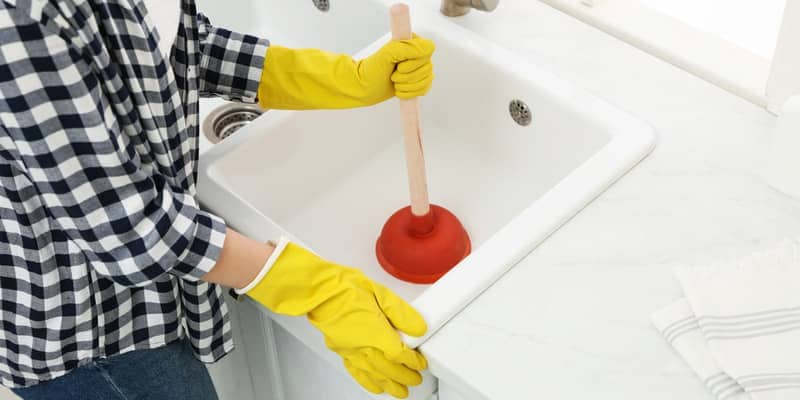
Before using a plunger, make sure you disconnect the insinkerator and plug up the dishwasher drain.
You don’t want to accidentally force debris and water into either appliance.
Fill the sink with a few inches of hot water, then start plunging. Use steady motions and don’t work too fast.
The clog should slowly begin to dissolve as the water drains.
Run more hot water down the drain. This will help you check if the clog has dissolved.
Using a drain snake
Check your local hardware store if they have a drain snake or plumber’s snake.
Insert it into the opening of the drain, and keep going until you feel it hit the clog.
Begin twisting the snake against the blockage until you feel it begin to loosen.
The end of the drain snake should latch onto whatever’s blocking your drain so you can pull it free or break it up into smaller clumps.
Flush the drain with hot water for several minutes to ensure all debris has been washed away.
Maintaining Your Kitchen
Knowing how to clean a kitchen sink is essential to the overall maintenance of your entire kitchen.
And maintaining your kitchen is essential to your personal health and food enjoyment!
A clean kitchen means good food and a happy home, so don’t shy away from getting down and dirty – you’ll be healthier in the long run.

